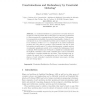Free Online Productivity Tools
i2Speak
i2Symbol
i2OCR
iTex2Img
iWeb2Print
iWeb2Shot
i2Type
iPdf2Split
iPdf2Merge
i2Bopomofo
i2Arabic
i2Style
i2Image
i2PDF
iLatex2Rtf
Sci2ools
IBERAMIA
2004
Springer
2004
Springer
Constrainedness and Redundancy by Constraint Ordering
Abstract. In constraint satisfaction, a general rule is to tackle the hardest part of a search problem first. In this paper, we introduce a parameter (τ) that measures the constrainedness of a search problem. This parameter represents the probability of a problem being feasible. A value of τ = 0 corresponds to an over-constrained problem and no states are expected to be solutions. A value of τ = 1 corresponds to an under-constrained problem and every state is a solution. This parameter can also be used in heuristics to guide search. To achieve this parameter, a simple random or systematic sampling is carried out to compute the tightnesses of each constraint. New heuristics are developed to classify the constraints from the tightest constraint to the loosest constraint and to remove redundant constraints in constraint satisfaction problems. These heuristics may accelerate the search due to inconsistencies can be found earlier and the absence of such redundant constraints eliminate u...
| Added | 01 Jul 2010 |
| Updated | 01 Jul 2010 |
| Type | Conference |
| Year | 2004 |
| Where | IBERAMIA |
| Authors | Miguel A. Salido, Federico Barber |
Comments (0)

